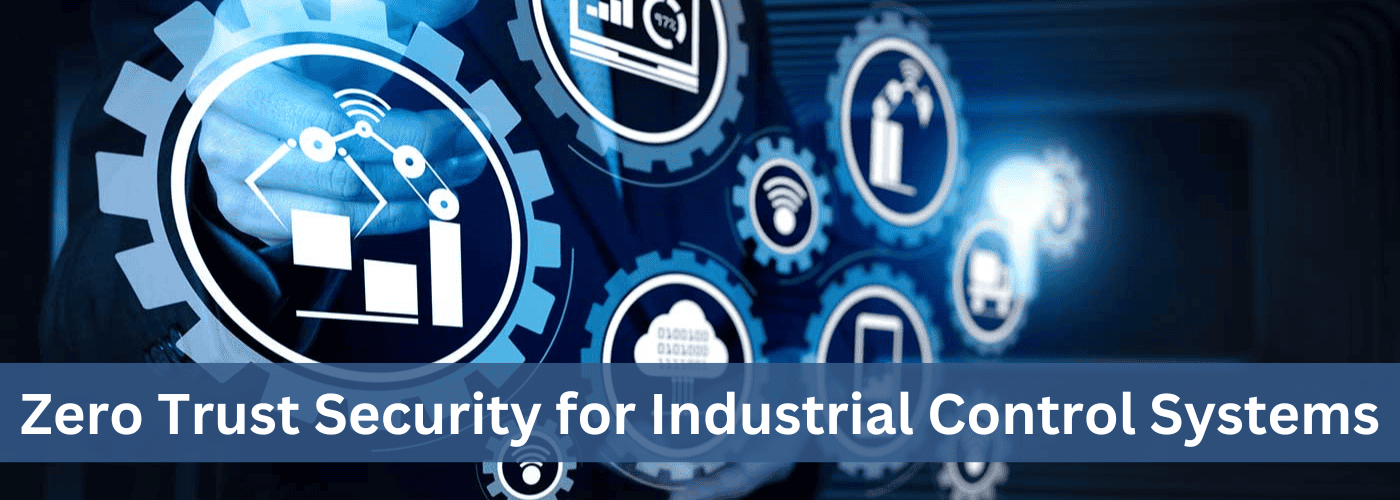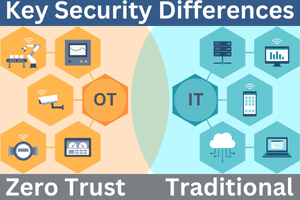Zero Trust: Reinforcing Security in Industrial Control Systems

As industrial control systems (ICS) become increasingly digitized, ensuring robust ICS security measures is paramount. In this article, we delve into the concept of Zero Trust and its potential to revolutionize the security landscape for industrial control systems. With cyber threats evolving in complexity and sophistication, traditional security measures are no longer sufficient. Zero Trust takes a proactive approach, challenging the assumption that trust can be automatically granted to any device or user within a network. Instead, it implements strict access controls and continuous monitoring, requiring every request to be verified and authenticated.
By adopting a Zero Trust model, organizations can effectively safeguard their industrial control systems from unauthorized access and potential breaches. This approach focuses on identity verification, least privilege access, and strict enforcement of security policies, bolstering defense mechanisms against cyberattacks. Furthermore, the implementation of Zero Trust aligns with industry best practices, providing a framework to mitigate risks and improve overall resilience.
In the next sections, we will explore the key principles of Zero Trust and its implementation strategies, providing insights into how organizations can reinforce security in their industrial control systems. Stay tuned to discover how this innovative approach can enhance your cybersecurity posture and protect critical infrastructure.
The Concept of Zero Trust OT / ICS Security
Traditional security models based on the concept of a trusted network perimeter have become increasingly insufficient. The traditional approach assumes that once a user or device is granted access to the network, they can be trusted to perform any actions within the system. However, this assumption has been shattered by the rise of sophisticated cyber threats, data breaches, and insider threats.
The concept of Zero Trust security challenges this outdated paradigm, advocating for a more proactive and comprehensive approach to safeguarding digital assets. Zero Trust is a security framework that operates on the principle of “never trust, always verify.” This means that every access request, whether from an internal or external source, must be thoroughly authenticated and authorized before granting any level of access.
The core tenet of Zero Trust is the elimination of implicit trust. Instead of relying on traditional perimeter-based security measures, such as firewalls and VPNs, Zero Trust emphasizes the continuous verification of user identities, device posture, and contextual factors. This approach ensures that access is granted based on the principle of least privilege, where users and devices are only granted the minimum level of access required to perform their tasks.
Traditional OT / ICS Security Approaches
Industrial Control Systems (ICS) are critical components of modern industrial infrastructure, responsible for monitoring and controlling various industrial processes, from manufacturing to energy production. Traditionally, ICS security has been approached with a focus on physical access control and air-gapped networks, where the systems were isolated from the broader corporate network or the internet.
This approach was based on the assumption that physical isolation and air-gapped networks would provide sufficient protection against cyber threats. At an earlier time, this was sufficient. However, as ICS have become increasingly interconnected and digitized, this traditional security model has proven to be inadequate in the face of evolving cyber risks.
The growing adoption of Industrial Internet of Things (IIoT) devices, remote access capabilities, and the integration of ICS with enterprise IT systems have expanded the attack surface, making ICS more vulnerable to cyber threats. Attackers can now exploit vulnerabilities in these interconnected systems to gain unauthorized access, disrupt operations, and even cause physical damage to critical infrastructure.
Limitations of Traditional OT / ICS Security Approaches
The traditional security approaches for ICS, which rely primarily on physical access control and air-gapped networks, have several limitations that make them ill-equipped to address the modern cybersecurity challenges.
Firstly, the assumption of a trusted network perimeter is no longer valid in the era of ubiquitous connectivity and remote access. Attackers can exploit vulnerabilities in the network or gain unauthorized access through compromised user credentials, rendering the physical isolation of ICS ineffective.
Secondly, the air-gapped network model, while providing a certain level of protection, is not impenetrable. Sophisticated attackers can find ways to bridge the air gap, either through the introduction of malware-infected removable media or by exploiting vulnerabilities in the communication channels between the ICS and the enterprise network.
Moreover, the traditional approach often relies on static security policies and access controls, which can be cumbersome to manage and fail to adapt to the dynamic nature of modern cyber threats. As new vulnerabilities and attack vectors emerge, the traditional security measures may become outdated and ineffective, leaving ICS vulnerable to evolving threats.
Understanding the Principles of Zero Trust OT / ICS Security
The principles of Zero Trust security provide a comprehensive framework for addressing the limitations of traditional security approaches in the context of Industrial Control Systems (ICS). The key principles of Zero Trust security include:
- Continuous verification: Zero Trust security requires continuous verification of user identities, device posture, and contextual factors before granting access to any resource. This approach eliminates the concept of a trusted network perimeter and assumes that every access request, regardless of its origin, must be thoroughly authenticated and authorized.
- Least privilege access: Zero Trust security follows the principle of least privilege, where users and devices are granted the minimum level of access required to perform their tasks. This helps to minimize the attack surface and reduce the potential impact of a successful breach.
- Micro-segmentation: Zero Trust security emphasizes the segmentation of the network into smaller, isolated zones or micro-perimeters. This approach limits the lateral movement of attackers within the network and reduces the risk of a single point of failure.
- Contextual awareness: Zero Trust security considers various contextual factors, such as user location, device type, and network activity, when making access decisions. This allows for more granular control and adaptive security policies that respond to changing risk profiles.
- Centralized policy enforcement: Zero Trust security relies on a centralized policy enforcement mechanism that governs access control and security policies across the entire network. This ensures consistent and unified security enforcement, reducing the risk of inconsistent or conflicting policies.
- Continuous monitoring and logging: Zero Trust security requires continuous monitoring of user activities, device behavior, and network traffic to detect anomalies and potential threats. Comprehensive logging and auditing capabilities are essential for threat detection, incident response, and compliance purposes.
By embracing these principles, organizations can build a robust and resilient security architecture that effectively safeguards their Industrial Control Systems against evolving cyber threats.
Implementing Zero Trust Security in Industrial Control Systems
Implementing Zero Trust security in the context of Industrial Control Systems (ICS) requires a comprehensive and strategic approach. Here are the key steps to consider:
- Inventory and asset management: The first step is to conduct a thorough inventory of all ICS assets, including devices, software, and communication protocols. This information is crucial for understanding the attack surface and developing appropriate security policies.
- Identity and access management: Implementing robust identity and access management (IAM) is a cornerstone of Zero Trust security. This involves establishing strong user authentication mechanisms, such as multi-factor authentication, and implementing granular access controls based on the principle of least privilege.
- Network segmentation and micro-perimeters: Dividing the ICS network into smaller, isolated segments or micro-perimeters is essential for limiting the lateral movement of potential attackers. This can be achieved through the use of network firewalls, virtual local area networks (VLANs), and software-defined networking (SDN) technologies.
- Continuous monitoring and threat detection: Implementing robust monitoring and threat detection capabilities is crucial for the success of a Zero Trust security implementation. This includes deploying security information and event management (SIEM) solutions, network traffic analysis tools, and endpoint detection and response (EDR) systems to continuously monitor and analyze activities within the ICS environment.
- Secure remote access: In the era of remote work and increased connectivity, secure remote access to ICS is a critical consideration. Zero Trust security principles should be applied to remote access, including the use of multi-factor authentication, secure VPN or zero-trust network access (ZTNA) solutions, and strict access controls.
- Vulnerability management and patch deployment: Maintaining a robust vulnerability management program and ensuring timely patch deployment are essential for mitigating known vulnerabilities in ICS components. This helps to reduce the attack surface and prevent successful exploitation by threat actors.
- Incident response and recovery planning: Developing comprehensive incident response and recovery plans is crucial for effectively responding to and recovering from security incidents. This includes establishing clear communication channels, defining roles and responsibilities, and implementing backup and disaster recovery strategies.
By following these implementation steps, organizations can gradually transition their ICS security posture towards a Zero Trust model, enhancing their overall resilience and protection against cyber threats.
Benefits of Zero Trust OT / ICS Security
Implementing a Zero Trust security approach in Industrial Control Systems (ICS) can provide numerous benefits, including:
- Enhanced security posture: By eliminating the concept of a trusted network perimeter and continuously verifying user and device access, Zero Trust security significantly reduces the risk of unauthorized access and potential data breaches within the ICS environment.
- Improved visibility and control: Zero Trust security provides increased visibility into user activities, device behavior, and network traffic, enabling security teams to detect and respond to anomalies and potential threats more effectively.
- Reduced attack surface: The principle of least privilege access and micro-segmentation in Zero Trust security helps to minimize the attack surface, making it more challenging for attackers to move laterally within the network and cause widespread damage.
- Adaptability to evolving threats: The dynamic nature of Zero Trust security, with its emphasis on continuous verification and contextual awareness, enables organizations to adapt their security posture more quickly to address emerging cyber threats and vulnerabilities.
- Compliance and regulatory alignment: Zero Trust security aligns with industry best practices and regulatory requirements, such as the National Institute of Standards and Technology (NIST) Cybersecurity Framework and the Industrial Internet Consortium (IIC) Industrial Internet Security Framework (IISF). This can simplify compliance efforts and demonstrate a robust security posture to auditors and regulators.
- Operational resilience: By implementing micro-segmentation and secure remote access, Zero Trust security can help maintain the operational continuity of ICS, even in the event of a security incident or a disaster, ensuring the uninterrupted delivery of critical services.
- Reduced operational costs: While the initial implementation of Zero Trust security may require significant investment, the long-term benefits can include reduced operational costs associated with incident response, data breaches, and compliance violations.
By embracing the principles of Zero Trust security, organizations can significantly enhance the protection of their Industrial Control Systems, mitigate cyber risks, and ensure the resilience of their critical infrastructure.
Case Studies of Successful Zero Trust Implementations in ICS
To illustrate the real-world application of Zero Trust security in Industrial Control Systems (ICS), let’s explore a few case studies:
- Petrochemical company: A large petrochemical company implemented a Zero Trust security framework to secure its ICS environment. The organization began by conducting a comprehensive asset inventory and mapping the communication flows within the ICS network. They then implemented micro-segmentation, using software-defined networking and virtual firewalls, to isolate critical systems and processes. Additionally, the company deployed multi-factor authentication for all remote access to ICS components and implemented continuous monitoring and threat detection capabilities. As a result, the company reported a significant reduction in the risk of unauthorized access and improved operational resilience.
- Water treatment facility: A municipal water treatment facility faced the challenge of securing its ICS, which included a mix of legacy and modern equipment. The organization adopted a Zero Trust approach, starting with the deployment of a centralized identity and access management system. This enabled the facility to enforce granular access controls and continuously verify user and device identities before granting access to ICS resources. The implementation also included network segmentation, secure remote access, and advanced threat detection capabilities. The water treatment facility reported improved visibility into their ICS environment, faster incident response, and better compliance with industry regulations.
- Power generation company: A large power generation company recognized the need to modernize its ICS security posture to address the growing cyber threats. The organization embarked on a Zero Trust security initiative, beginning with a comprehensive risk assessment and asset inventory. They then implemented a Zero Trust architecture, which included the deployment of a secure access service edge (SASE) solution, micro-segmentation of the ICS network, and the integration of advanced threat detection and response capabilities. The power generation company reported a significant reduction in the attack surface, improved operational resilience, and enhanced compliance with industry-specific cybersecurity standards.
These case studies demonstrate the practical application of Zero Trust security principles in various ICS environments, highlighting the benefits of this approach in enhancing overall security, operational resilience, and compliance with industry regulations.
Challenges and Considerations for Implementing Zero Trust in ICS
While the adoption of Zero Trust security in Industrial Control Systems (ICS) offers numerous benefits, organizations may face several challenges and considerations during the implementation process:
- Legacy system integration: Many ICS environments include legacy equipment and systems that may not be compatible with modern security technologies or protocols required for Zero Trust implementation. Integrating these legacy components into a Zero Trust architecture can be a complex and resource-intensive process. One way to provide security for legacy equipment is to implement an overlay security solution that is transparent to the network and requires no changes.
- Data and system availability: Implementing Zero Trust security measures, such as continuous monitoring and micro-segmentation, may impact the availability and performance of ICS components, which are often designed for real-time responsiveness. Organizations must carefully balance security requirements with operational needs to avoid disrupting critical processes.
- Organizational culture and change management: Transitioning to a Zero Trust security model often requires a significant shift in organizational mindset and culture. Employees may be resistant to the increased security measures and the need for continuous verification. Effective change management and communication strategies are crucial for successful implementation.
- Skill gaps and training: Implementing and maintaining a Zero Trust security framework in ICS environments may require specialized skills and expertise that may not be readily available within the organization. Investing in employee training and upskilling can help bridge this gap and ensure the successful deployment and ongoing management of the Zero Trust solution. For ICS edge device protection with Veridify’s DOME solution, Zero Trust can be implement by existing technicians with no Cyber/IT expertise.
- Vendor and supply chain considerations: ICS environments often involve a complex ecosystem of vendors and suppliers. Ensuring that the entire supply chain adheres to Zero Trust principles, including secure remote access and continuous monitoring, can be a significant challenge that requires collaboration and coordination with external stakeholders.
- Regulatory and compliance requirements: ICS are subject to various industry-specific regulations and standards, such as the IEC 62443 series for industrial automation and control systems security. Implementing Zero Trust security must be done in a way that aligns with these regulatory requirements to avoid compliance issues.
- Cost and resource allocation: Transitioning to a comprehensive Zero Trust security model can be a significant investment, both in terms of financial resources and personnel. Organizations must carefully evaluate the costs and allocate the necessary resources to ensure the successful implementation and ongoing maintenance of the Zero Trust architecture.
By addressing these challenges and considerations, organizations can overcome the obstacles and successfully implement a Zero Trust security framework in their Industrial Control Systems, ultimately enhancing their overall cybersecurity posture and resilience.
Conclusion: Embracing a Zero Trust Mindset for OT / ICS Security
The security of Industrial Control Systems (ICS) is a critical concern for organizations across various industries. Traditional security approaches, which rely on the assumption of a trusted network perimeter, have proven to be inadequate in the face of sophisticated cyber threats and the increasing interconnectivity of ICS.
The concept of Zero Trust security presents a transformative solution to this challenge, challenging the traditional security paradigm and advocating for a more proactive and comprehensive approach to safeguarding ICS environments. By implementing the principles of continuous verification, least privilege access, micro-segmentation, and centralized policy enforcement, organizations can significantly enhance the security and resilience of their critical industrial infrastructure.
The adoption of Zero Trust security in ICS can provide numerous benefits, including improved visibility and control, reduced attack surface, enhanced operational resilience, and better alignment with industry regulations and best practices. While the implementation process may present some challenges, such as legacy system integration and organizational change management, the long-term advantages of a Zero Trust security framework make it a compelling choice for organizations seeking to fortify their cybersecurity posture.
As the digital transformation of industrial systems continues to accelerate, embracing a Zero Trust mindset for ICS security is not just a recommendation, but a necessity. By proactively addressing the evolving cyber threats and adopting innovative security approaches, organizations can safeguard their critical assets, maintain operational continuity, and ensure the resilience of their industrial infrastructure in the face of an ever-changing threat landscape.



